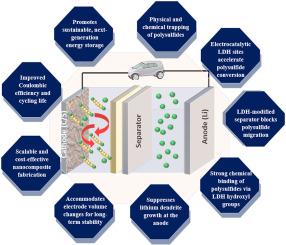Advancing lithium-sulfur batteries using layered double hydroxide (LDH) -based nanocomposites: Progress, performance, challenges, and future prospects for energy storage
IF 7.9
2区 工程技术
Q1 CHEMISTRY, PHYSICAL
引用次数: 0
Abstract
Lithium-sulfur (Li-S) batteries hold great promise for next-generation energy storage system owing to the high theoretical energy density of sulfur. However, there are some existing issues such as the polysulfide shuttle effect, poor electrical conductivity of sulfur, and considerable volume changes during cycling which has remined as the significant challenges. This review analyzes the multifaceted role of layered double hydroxides (LDHs) to overcome these challenges by serving not only as sulfur-hosting matrices but also as polysulfide-trapping separator coatings and electrolyte additives. This review highlights that LDHs has combined physical confinement and chemical binding to effectively suppress polysulfide dissolution and migration, while their integration with conductive materials significantly enhances the electrochemical performance of sulfur. Additionally, this review elucidates the design of LDH architectures that accommodate volume changes, thereby improving the electrode stability and cycling life. Finally, a strategic roadmap for advancing LDH-based materials as scalable, economically viable, and practical Li-S battery applications is proposed, that has addressed the current gaps and future research directions.

利用层状双氢氧化物(LDH)基纳米复合材料推进锂硫电池:储能的进展、性能、挑战和未来前景
由于硫的理论能量密度高,锂硫电池在下一代储能系统中具有很大的应用前景。然而,多硫化物的穿梭效应、硫的导电性差、循环过程中体积变化大等问题仍然是目前存在的重大挑战。本文分析了层状双氢氧化物(LDHs)在克服这些挑战方面的多方面作用,它不仅可以作为硫载体基质,还可以作为多硫化物捕获隔膜涂层和电解质添加剂。这篇综述强调了LDHs结合了物理约束和化学结合,有效地抑制了多硫化物的溶解和迁移,而与导电材料的结合显著提高了硫的电化学性能。此外,这篇综述阐明了LDH结构的设计,以适应体积的变化,从而提高电极的稳定性和循环寿命。最后,提出了将ldh基材料推进为可扩展、经济可行和实用的Li-S电池应用的战略路线图,解决了当前的差距和未来的研究方向。
本文章由计算机程序翻译,如有差异,请以英文原文为准。
求助全文
约1分钟内获得全文
求助全文
来源期刊

Journal of Power Sources
工程技术-电化学
CiteScore
16.40
自引率
6.50%
发文量
1249
审稿时长
36 days
期刊介绍:
The Journal of Power Sources is a publication catering to researchers and technologists interested in various aspects of the science, technology, and applications of electrochemical power sources. It covers original research and reviews on primary and secondary batteries, fuel cells, supercapacitors, and photo-electrochemical cells.
Topics considered include the research, development and applications of nanomaterials and novel componentry for these devices. Examples of applications of these electrochemical power sources include:
• Portable electronics
• Electric and Hybrid Electric Vehicles
• Uninterruptible Power Supply (UPS) systems
• Storage of renewable energy
• Satellites and deep space probes
• Boats and ships, drones and aircrafts
• Wearable energy storage systems
 求助内容:
求助内容: 应助结果提醒方式:
应助结果提醒方式:


